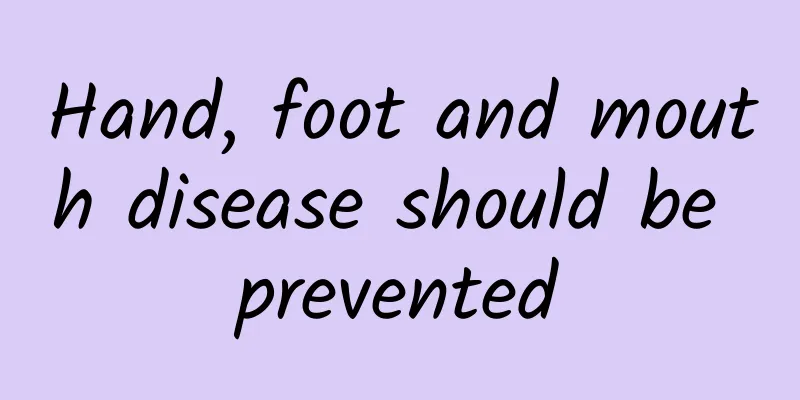Hand, foot and mouth disease should be prevented

|
The weather is getting warmer, parents should pay attention, we are about to enter the high incidence season of hand, foot and mouth disease 1. What is hand, foot and mouth disease? Hand, foot and mouth disease (HFMD) is a common infectious disease in children caused by enterovirus (EV) infection. It is more common in children under 5 years old, and the incidence rate is even higher in children under 3 years old. Hand, foot and mouth disease is a global disease that occurs throughout the year in various parts of my country. The incidence rate is 37.01/100 000 to 205.06/100 000. In recent years, the reported mortality rate has been between 6.46/100 000 and 51.00/100 000. 2. What are the clinical manifestations of hand, foot and mouth disease? Incubation period: usually 2 to 10 days, average 3 to 5 days. Stage 1 (rash stage): This stage belongs to the common type of hand, foot and mouth disease, and most people recover in this stage. Stage 2 (neurological system involvement stage): This stage is the most severe case of hand, foot and mouth disease, and most cases can recover. Stage 3 (early stage of cardiopulmonary failure): This stage is the critical stage of severe cases of hand, foot and mouth disease. Timely identification and correct treatment are the key to reducing the mortality rate. Stage 4 (cardiopulmonary failure): This stage is the severe and critical stage of hand, foot and mouth disease, with a high mortality rate. Stage 5 (recovery stage): Most children have a good prognosis and generally recover within 1 week without any sequelae. 3. Five characteristics of hand, foot and mouth disease Herpes appears on the hands, feet, mouth and other parts of the body. The rash may also appear on the buttocks or knees. Scattered herpes appear on the oral mucosa, causing obvious pain. Some children have symptoms such as cough, runny nose, loss of appetite, nausea, vomiting and headache. Children with serious illness may suffer from muscle spasms or encephalitis, acute flaccid paralysis, cardiopulmonary failure, pulmonary edema, etc. 4. Treatment of hand, foot and mouth disease There is currently no specific anti-enteroviral drug, so the treatment of hand, foot and mouth disease should try to relieve symptoms and carry out corresponding symptomatic treatment. Actively control high fever. For patients with a body temperature above 38.5°C, use physical cooling (warm water bath, use of antipyretic patch, etc.) or antipyretic drugs. Commonly used drugs include: oral ibuprofen, 5-10 mg/(kg·time); oral acetaminophen, 10-15 mg/(kg·time); The minimum interval between two doses is 6 hours. Keep the child quiet. Convulsions require immediate treatment. Pay attention to nutritional support and maintain water and electrolyte balance. Use oral rehydration salts to replenish water and electrolytes if vomiting occurs. If your baby has oral ulcers, try to eat liquid food and cold food to avoid pain caused by ulcers. Note: If the condition is serious, seek medical attention immediately. 5. Home care for hand, foot and mouth disease Note on isolation: Children should be isolated at home for two weeks. Light diet: Try to eat liquid and cold food. Make sure you drink enough fluids: If you have vomiting, use oral rehydration salts to replenish water and electrolytes. Pay attention to hygiene: take good care of your oral and skin, ventilate the room, and wash your hands frequently. 6. Pay attention to these symptoms and seek medical attention immediately! If a high fever persists for more than 48 hours, conventional antipyretic drugs will not be effective. Poor spirits, excessive sleep during the day, easy awakening, irritability. Respiration and heart rate increase, breathing becomes difficult, and lips turn purple. The face is pale, the skin has spots, the limbs are cold, and there is cold sweat. Children under 3 years old, especially those with an illness course of less than 5 days, may develop into a critical illness in a short period of time. They should be closely monitored for changes in their condition and seek medical attention promptly if any changes occur. 7. Prevention of Hand, Foot and Mouth Disease General preventive measures: Maintaining good personal hygiene habits is the key to preventing hand, foot and mouth disease. Wash hands frequently and do not let children drink raw water or eat raw or cold food. Children's toys and items they frequently touch should be cleaned and disinfected regularly. Avoid close contact between children and children with hand, foot and mouth disease. Vaccination: EV-A71 inactivated vaccine can be used to prevent hand, foot and mouth disease caused by EV-A71 infection in children aged 6 months to 5 years. The basic immunization program is 2 doses, with an interval of 1 month. It is encouraged to complete the vaccination before 12 months of age. 8. Five Tips for Preventing Hand, Foot and Mouth Disease Wash hands frequently, eat cooked food, drink boiled water, ventilate frequently, and dry clothes and quilts 9. Remember the seven-step hand washing method for disease prevention Step 1: Wash your palms; Step 2: Wash the back of your fingers; Step 3: Wash the palm of your fingers; Step 4: Wash the back of your fingers; Step 5: Wash your thumbs; Step 6: Wash your fingertips; Step 7: Wash your wrists and arms (Wang Ruiqin, Qingdao Women and Children's Hospital) |
Recommend
Are black or red persimmons better? What are the characteristics of Fuping persimmons?
Persimmon has the effects of clearing heat, moist...
How to remove blood clots after miscarriage
In order to save money or to protect their reputa...
How much blood will flow in a threatened miscarriage?
Threatened abortion may cause vaginal bleeding or...
What to do if you have hereditary small breasts
Breast development is an issue that many people a...
Gartner: Android OS sales market share in Q3 2011 was 52.5%
According to research data released by Gartner, i...
What are the benefits of eating broccoli? How to choose broccoli
Broccoli is one of the vegetables that contains t...
Can an 8-month pregnant woman cut her hair?
Today's expectant mothers are extremely conce...
Is it serious if a pregnant woman falls and lands on her butt?
After becoming pregnant, women need to be extra c...
What is the cause of diarrhea?
People know that menstrual cramps are common, and...
What is the best fishing depth on a day when the temperature drops? Why is it good for fishing when the temperature drops?
As we all know, weather is a decisive factor affe...
How to judge ectopic pregnancy after transplantation
Ectopic pregnancy is the most easily misdiagnosed...
Google: Smartphone usage during game viewing
While there's no evidence this year that smar...
14 weeks pregnant left lower abdomen pain
Many pregnant women experience persistent lower a...
Will you get vaginitis if you put on clothes "instantly" after taking a shower? 9 little-known facts about women that many people don't know!
I believe that everyone has heard some little-kno...
What causes cervical cysts?
The cervix is an important organ of women. Cerv...









